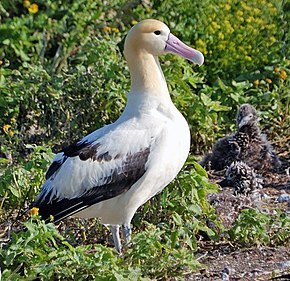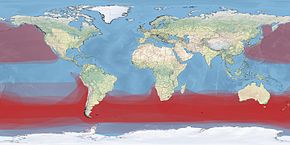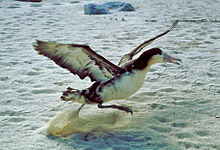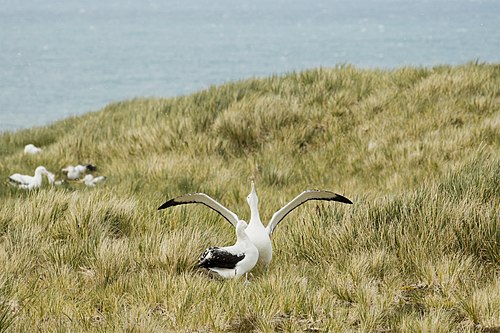| Albatross Temporal range: Oligocene–recent Oligocene–recent | |
|---|---|
 | |
| Short-tailed albatross (Phoebastria albatrus) | |
 | |
| Global range density (in red) |
Albatrosses, of the biological family Diomedeidae, are large seabirdsrelated to the procellariids, storm petrels and diving petrels in the order Procellariiformes (the tubenoses). They range widely in the Southern Oceanand the North Pacific. They are absent from the North Atlantic, although fossil remains show they once occurred there and occasional vagrants are found. Albatrosses are among the largest of flying birds, and the genusgreat albatrosses have the longest wingspans of any extant birds, reaching up to 3.7 metres (12 feet). The albatrosses are usually regarded as falling into four genera, but there is disagreement over the number of species.
Albatrosses are highly efficient in the air, using dynamic soaring and slope soaring to cover great distances with little exertion. They feed on squid, fishand krill by either scavenging, surface seizing or diving. Albatrosses are colonial, nesting for the most part on remote oceanic islands, often with several species nesting together. Pair bonds between males and females form over several years, with the use of "ritualised dances", and will last for the life of the pair. A breeding season can take over a year from laying to fledging, with a single egg laid in each breeding attempt. A Laysan albatross, named Wisdom, on Midway Island is recognised as the oldest wild bird in the world; she was first banded in 1956 by Chandler Robbins.[2]
Of the 22 species of albatross recognised by the IUCN, all are listed as at some level of concern; 3 species are Critically Endangered, 5 species are Endangered, 7 species are Near Threatened, and 7 species are Vulnerable. Numbers of albatrosses have declined in the past due to harvesting for feathers, but today the albatrosses are threatened by introduced species, such as rats and feral cats that attack eggs, chicks and nesting adults; by pollution; by a serious decline in fish stocks in many regions largely due to overfishing; and by longline fishing. Longline fisheries pose the greatest threat, as feeding birds are attracted to the bait, become hooked on the lines, and drown. Identified stakeholders such as governments, conservation organisations and people in the fishing industry are all working toward reducing this bycatch.
...
The albatrosses are a group of large to very large birds; they are the largest of the procellariiformes. The bill is large, strong and sharp-edged, the upper mandible terminating in a large hook. This bill is composed of several horny plates, and along the sides are the two "tubes", long nostrils that give the order its former name. The tubes of all albatrosses are along the sides of the bill, unlike the rest of the Procellariiformes where the tubes run along the top of the bill. These tubes allow the albatrosses to measure the exact airspeed in flight; the nostrils are analogous to the pitot tubes in modern aircraft. The albatross needs accurate airspeed measurement in order to perform dynamic soaring. Like other Procellariiformes, they use their uniquely developed sense of smell to locate potential food sources, whereas most birds depend on eyesight.[13] The feet have no hind toe and the three anterior toes are completely webbed. The legs are strong for Procellariiformes, making them and the giant petrels the only members of that order which can walk well on land.[14]
Albatrosses, along with all Procellariiformes, must excrete the salts they ingest in drinking sea water and eating marine invertebrates. All birds have an enlarged nasal gland at the base of the bill, above their eyes. This gland is inactive in species that do not require it, but in the Procellariiformes it acts as a salt gland. Scientists are uncertain as to its exact processes, but do know in general terms that it removes salt by secreting a 5% saline solution that drips out of their nose or is forcibly ejected.[15]
The adult plumage of most of the albatrosses is usually some variation of dark upper-wing and back with white undersides, often compared to that of a gull.[14] The extent of colouration varies: the southern royal albatross is almost completely white except for the ends and trailing edges of the wings in fully mature males, while the Amsterdam albatross has an almost juvenile-like breeding plumage with a great deal of brown, particularly a strong brown band around the chest. Several species of mollymawks and North Pacific albatrosses have face markings like eye patches or have grey or yellow on the head and nape. Three albatross species, the black-footed albatross and the two sooty albatrosses, vary completely from the usual patterns and are almost entirely dark brown (or dark grey in places in the case of the light-mantled albatross). Albatrosses take several years to get their full adult breeding plumage.[3]
The wingspans of the largest great albatrosses (genus Diomedea) are the largest of any bird, exceeding 340 cm (11.2 ft), although the other species' wingspans are considerably smaller at no more than 1.75 m (5.7 ft).[16] The wings are stiff and cambered, with thickened streamlined leading edges. Albatrosses travel huge distances with two techniques used by many long-winged seabirds: dynamic soaring and slope soaring. Dynamic soaring involves repeatedly rising into wind and descending downwind, thus gaining energy from the vertical wind gradient. The only effort expended is in the turns at the top and bottom of every such loop. This maneuver allows the bird to cover almost a thousand kilometres a day without flapping its wings. Slope soaring uses the rising air on the windward side of large waves. Albatross have high glide ratios, around 22:1 to 23:1, meaning that for every metre they drop, they can travel forward 22 metres.[3] They are aided in soaring by a shoulder-lock, a sheet of tendon that locks the wing when fully extended, allowing the wing to be kept outstretched without any muscle expenditure, a morphological adaptation they share with the giant petrels.[17]
Albatrosses combine these soaring techniques with the use of predictable weathersystems: albatrosses in the Southern Hemisphere flying north from their colonies will take a clockwise route, and those flying south will fly counterclockwise.[14]Albatrosses are so well adapted to this lifestyle that their heart rates while flying are close to their basal heart rate when resting. This efficiency is such that the most energetically demanding aspect of a foraging trip is not the distance covered, but the landings, take-offs and hunting they undertake having found a food source.[18] A common assumption is that albatrosses must be able to sleep in flight, although no direct evidence has ever been obtained.[19]
This efficient long-distance travelling underlies the albatross's success as a long-distance forager, covering great distances and expending little energy looking for patchily distributed food sources. Their adaptation to gliding flight makes them dependent on wind and waves, however, as their long wings are ill-suited to powered flight and most species lack the muscles and energy to undertake sustained flapping flight. Albatrosses in calm seas rest on the ocean's surface until the wind picks up again as it is not energetically worthwhile using powered flight, though they are capable of flight to avoid danger [20]. The North Pacific albatrosses can use a flight style known as flap-gliding, where the bird progresses by bursts of flapping followed by gliding.[21] When taking off, albatrosses need to take a run up to allow enough air to move under the wing to provide lift.[14]
The dynamic soaring of albatrosses is inspiring to airplane designers: German aerospace engineer Johannes Traugottand colleagues have charted the albatross's nuanced flight pattern and are looking for ways to apply this to aircraft, especially in the area of drones and unmanned aircraft.[22]
...
Breeding and dancing[edit]
Albatrosses are colonial, usually nesting on isolated islands; where colonies are on larger landmasses, they are found on exposed headlands with good approaches from the sea in several directions, like the colony on the Otago Peninsula in Dunedin, New Zealand. Many Buller's albatrosses and black-footed albatrosses nest under trees in open forest.[29] Colonies vary from the very dense aggregations favoured by the mollymawks (black-browed albatross colonies on the Falkland Islands have densities of 70 nests per 100 m2) to the much looser groups and widely spaced individual nests favoured by the sooty and great albatrosses. All albatross colonies are on islands that historically were free of land mammals. Albatrosses are highly philopatric, meaning they will usually return to their natal colony to breed. This tendency to return to their point of origin to breed is so strong that a study of Laysan albatross showed that the average distance between hatching site and the site where a bird established its own territory was 22 m (72 ft).[30]
Albatrosses live much longer than other birds; they delay breeding for longer and invest more effort into fewer young. Most species survive upwards of 50 years, the oldest recorded being a Laysan albatross named Wisdom that was ringed in 1956 as a mature adult and hatched another chick in February 2017, making her at least 66 years old. She is the oldest confirmed wild bird as well as the oldest banded bird in the world.[31][32]
Albatrosses reach sexual maturity slowly, after about five years, but even once they have reached maturity, they will not begin to breed for another couple of years (even up to 10 years for some species). Young non-breeders will attend a colony prior to beginning to breed, spending many years practising the elaborate breeding rituals and "dances" that the family is famous for.[33] Birds arriving back at the colony for the first time already have the stereotyped behaviours that compose albatross language, but can neither "read" that behaviour as exhibited by other birds nor respond appropriately.[14] After a period of trial and error learning, the young birds learn the syntax and perfect the dances. This language is mastered more rapidly if the younger birds are around older birds.
The repertoire of behaviour involves synchronised performances of various actions such as preening, pointing, calling, bill clacking, staring, and combinations of such behaviours (like the sky-call).[34] When a bird first returns to the colony it will dance with many partners, but after a number of years the number of birds an individual will interact with drops, until one partner is chosen and a pair is formed. They then continue to perfect an individual language that will eventually be unique to that one pair. Having established a pair bond that will last for life, however, most of that dance will never be used again.
Albatrosses are held to undertake these elaborate and painstaking rituals to ensure that the appropriate partner has been chosen and to perfect partner recognition, as egg laying and chick rearing is a huge investment. Even species that can complete an egg-laying cycle in under a year seldom lay eggs in consecutive years.[3] The great albatrosses (like the wandering albatross) take over a year to raise a chick from laying to fledging. Albatrosses lay a single subelliptical[16] egg, white with reddish brown spots,[29] in a breeding season; if the egg is lost to predators or accidentally broken, then no further breeding attempts are made that year. The larger eggs weigh from 200 to 510 g (7.1–18.0 oz).[29] The "divorce" of a pair is a rare occurrence, due to the diminished life-time reproductive success it causes, and usually happens only after several years of breeding failure.[3]
All the southern albatrosses create large nests for their egg, utilizing grass, shrubs, soil, peat, and even penguinfeathers,[29] whereas the three species in the North Pacific make more rudimentary nests. The waved albatross, on the other hand, makes no nest and will even move its egg around the pair's territory, as much as 50 m (160 ft), sometimes causing it to lose the egg.[35] In all albatross species, both parents incubate the egg in stints that last between one day and three weeks. Incubation lasts around 70 to 80 days (longer for the larger albatrosses), the longest incubation period of any bird. It can be an energetically demanding process, with the adult losing as much as 83 g (2.9 oz) of body weight a day.[36]
After hatching, the chick, which is semi-altricial,[16] is brooded and guarded for three weeks until it is large enough to defend and thermoregulate itself. During this period the parents feed the chick small meals when they relieve each other from duty. After the brooding period is over, the chick is fed in regular intervals by both parents. The parents adopt alternative patterns of short and long foraging trips, providing meals that weigh around 12% of their body weight (around 600 g (21 oz)). The meals are composed of fresh squid, fish and krill, as well as stomach oil, an energy-rich food that is lighter to carry than undigested prey items. This oil is created in a stomach organ known as a proventriculus from digested prey items by most Procellariiformes, and gives them their distinctive musty smell.[37]
Albatross chicks take a long time to fledge. In the case of the great albatrosses, it can take up to 280 days; even for the smaller albatrosses, it takes anywhere between 140 and 170 days.[38] Like many seabirds, albatross chicks will gain enough weight to be heavier than their parents, and prior to fledging they use these reserves to build up body condition (particularly growing all their flight feathers), usually fledging at the same weight as their parents. Between 15% and 65% of those fledged survive to breed.[29] Albatross chicks fledge on their own and receive no further help from their parents, who return to the nest after fledging, unaware their chick has left. Studies of juveniles dispersing at sea have suggested an innate migration behaviour, a genetically coded navigation route, which helps young birds when they are first out at sea










No comments:
Post a Comment